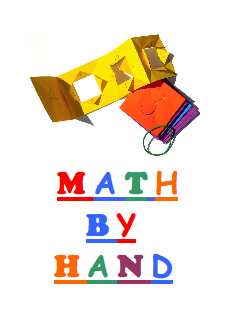
Day 106
For one year, 365 days, this blog will address the Common Core Standards from the perspective of creating an alternate, ambient learning environment for math. Ambient is defined as “existing or present on all sides, an all-encompassing atmosphere.” And ambient music is defined as: “Quiet and relaxing with melodies that repeat many times.”
Why ambient? A math teaching style that’s whole and all encompassing, with themes that repeat many times through the years, is most likely to be effective and successful. Today’s standard will be listed in blue, followed by its ambient counterpart.
Number and Operations in Base Ten 1.NBT
Use place value understanding and properties of operations to add and subtract.
4. Add within 100, including adding a two-digit number and a one-digit number, and adding a two-digit number and a multiple of ten, using concrete models or drawings and strategies based on place value, properties of operations, and/or the relationship between addition and subtraction; relate the strategy to a written method and explain the reasoning used. Understand that in adding two-digit numbers, one adds tens and tens, ones and ones, and sometimes it is necessary to compose a ten.
Ah, the Common Core. Again, unfamiliar territory tends to be introduced with interpretive lessons and homework that seem unnecessarily unwieldy and complex. I’m afraid that the concrete models or drawings and strategies have taken the form of the polka dots and hash marks that have puzzled parents and children alike and appeared so frequently online and in the media. The rushed implementation that’s resulted in inadequate orientation for teachers may be responsible for some of the confusion. But complicating a simple 2-step equation with a mega multi-step solution that includes complex visuals is questionable at best.
“Explaining the reasoning used” is really beyond the innate logical ability of a 6-7 year old. Or, considering Piaget’s theory of child development recommending concrete vs abstract thinking from ages 7-12, any child under 12 for that matter. The now famous example of a second grader’s “constructed response” illustrates the fact that the capacity to reason abstractly has not yet dawned. See the actual second grade Q&A below.
Place value per se is not brought in the Waldorf or Math By Hand method until Grade 2, when it’s taught with large, colorful manipulatives. Four color-coded columns are placed on the floor with large numbers for the 1’s, 10’s, 100’s, and 1,000’s place values, and small numbers that are physically jumped all the way to the tops of the columns. This will be explored in depth in the Grade 2 posts. For now in Grade 1, the 4 processes continue to be practiced side-by side, so that the relationship, not only of addition to subtraction, but of all 4 to each other, is continually experienced. Equations are kept in a horizontal format until the end of Grade 1 or the beginning of Grade 2, when they are switched to a vertical format.
As always, it’s the movement, story, and art that win the day with math! Knowledge ensues in an environment dedicated to imaginative, creative knowing, where student and teacher alike surrender to the ensuing of that knowledge as a worthy goal. More Common Core Grade 1 Number and Operations in Base Ten Standards with their ambient counterparts tomorrow!
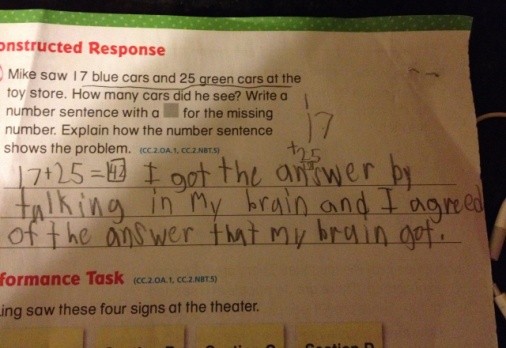
Tags:
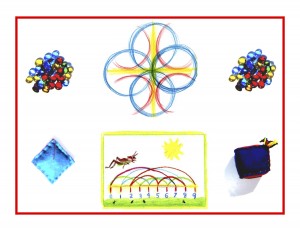
Day 105
For one year, 365 days, this blog will address the Common Core Standards from the perspective of creating an alternate, ambient learning environment for math. Ambient is defined as “existing or present on all sides, an all-encompassing atmosphere.” And ambient music is defined as: “Quiet and relaxing with melodies that repeat many times.”
Why ambient? A math teaching style that’s whole and all encompassing, with themes that repeat many times through the years, is most likely to be effective and successful. Today’s standard will be listed in blue, followed by its ambient counterpart.
Number and Operations in Base Ten 1.NBT
Understand place value.
3. Compare two-digit numbers based on meanings of the tens and ones digits, recording the results of comparisons with the symbols >, =, and <.
After becoming familiar with the -teens and -ty’s along with regular practice counting to 100 or 120, the above exercise can be attempted with lots of support, if needed. As always, any new concept should be introduced with a story! Here’s the equations and equivalency story from the Grade 1 Daily Lesson Plans book.
Equations / Equivalency
The numbers love to play, alone and in teams. Often their games are tied, with both sides scoring the same. The equals sign is a good score keeper who sees both sides. The numbers also like to compete one on one, to show whose value is greater or less. Then they use a special sign, one that cheers the greater number, turning away from the number that’s less. (A “talking” gesture with your fingertips shows the “greater-less than” sign.)
The hand gestures that accompany the story clearly show not only the operations signs for equal and greater-less than, but show their functions and meanings as well. This story could be told after the two-digit numbers are well established using story, art, and movement. The day after the story is told, the children retell it and then draw a colorful picture of it. The concept is practiced after this, with manipulatives and real numbers first, then on paper.
The morning circle is an excellent time to practice this as well. The teacher could call out two numbers and have the child repeat the numbers along with using the hand gestures mentioned in the story. Here are some examples with the accompanying gestures: 18 and 18 / equal sign (Hold hands in front, palms down facing different directions, with index fingers slightly pointed.) 27 and 30 / greater-less than sign (A “talking” gesture with fingertips, the open end (fingers) toward the 30 and closed end (wrist) toward the 27.) The two numbers could be represented by a closed fist held up in the proper position as each number is said.
As always, it’s the movement, story, and art that win the day with math! Knowledge ensues in an environment dedicated to imaginative, creative knowing, where student and teacher alike surrender to the ensuing of that knowledge as a worthy goal. More Common Core Grade 1 Number and Operations in Base Ten Standards with their ambient counterparts tomorrow!
Tags:
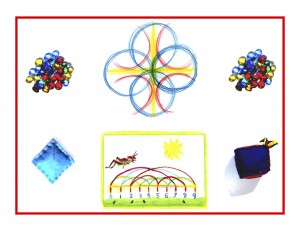
Day 104
For one year, 365 days, this blog will address the Common Core Standards from the perspective of creating an alternate, ambient learning environment for math. Ambient is defined as “existing or present on all sides, an all-encompassing atmosphere.” And ambient music is defined as: “Quiet and relaxing with melodies that repeat many times.”
Why ambient? A math teaching style that’s whole and all encompassing, with themes that repeat many times through the years, is most likely to be effective and successful. Today’s standard will be listed in blue, followed by its ambient counterpart.
Number and Operations in Base Ten 1.NBT
Understand place value.
2. Understand that the two digits of a two-digit number represent amounts of tens and ones. Understand the following as special cases:
a) 10 can be thought of as a bundle of ten ones — called a “ten.”
b) The numbers from 11 to 19 are composed of a ten and one, two, three, four, five, six, seven, eight, or nine ones.
c) The numbers 10, 20, 30, 40, 50, 60, 70, 80, 90 refer to one, two, three, four, five, six, seven, eight, or nine tens (and 0 ones).
Yesterday’s post fits today’s standard perfectly! So I will copy and paste it with a few additions, along with an illustration of the -teens and -ty’s in the story at the bottom of this post. This is also a good example of how to work in a main lesson book. Ideally, the pages of the book should be at least 9″ x 12″ and blank rather than lined. Organizing content on a blank page is a wonderfully effective exercise! (Note that guidelines for printing can be created with a yellow crayon.)
Waldorf Ed and Math By Hand do not teach place value until Grade 2. In Grade 1 however, there needs to be a bridge or transition from the numbers 1-12 after they’ve been slowly and carefully taught (each one accompanied by a story, a geometric form, and lots of movement) to the -teens and -ty’s (20, 30, 40, etc) up to 100. In the Math By Hand Grade 1 Binder, lessons are aligned to California State and National Math Standards. Before the inception of the Common Core, the requirement for Grade 1 was counting up to 100. (At this time I am not planning on revising the standards since Common Core is so much in flux. Besides, the old standards are more user-friendly, child-friendly and developmentally appropriate.) Here is an excerpt from the Math By Hand Grade 1 Binder:
Count, read, and write whole numbers to 100. Know 2s, 5s, 10s to 100.
Move beyond the number 12 to teach the -teens, with glass gems as counters. Using a piece of newsprint paper, draw 10 large ovals (about the size of an egg) in a vertical column on the left, spacing them evenly. Then add gems to each one, 1 for 11, 2 for 12, etc. Replace the gems with color dots, and write each number and its word out on the right side. Have the child(ren) copy yours as you model it on paper or the board. Note that the words for eleven and twelve are different. Their origins go back to the early use of Arabic numerals. The word “eleven” comes from an Old English word meaning, “one left over.” And “twelve,” from a word meaning “two left over.” Except for thirteen and fifteen, the rest just add the suffix -teen to the number. Both suffixes -teen and -ty derive from the word “ten.” Try telling a story like this while showing it visually.
Once upon a time, the numbers were happy to be a small family, from 1 – 10. They knew and understood each other very well, though each one was so different. Then one day, they were asked to count 2 more things than 10. They called the first one “eleven” or “one left over,” and the second one, “twelve,” or “two left over.” Then, they were called upon to count so much more that they needed to put the numbers together with 10. That’s how the -teens came about, with all the numbers having to stand next to 10. The numbers stood SO close together, that they squeezed the “0” out. Then the things that had to be counted grew and grew to be so many that the 10’s had to stand together, asking all the other numbers to stand there with them. These were called the -ty’s (say “tees”). So, twenty is two 10’s, and thirty is three. First, all of the “1’s” were squeezed out by the other numbers, then the other “0’s” were. So, for example, 3 10s became 30, and 3 10s + 3 became 33!
Include all the numbers to 90, then say that one hundred is ten 10’s. No need to show all the numbers visually, just a sampling’s enough. Be sure to use the Real Numbers as props, then go on to illustrate the -teens and -ty’s on separate pages.
So the child is brought along slowly and carefully, in a very pictorial way. Lots of illustration and color make up the heart of this lesson and activity. The image below illustrates the story, using real numbers as props. The real numbers can either be placed as manipulatives above the written numbers or worked with separately, then drawn on the top of the page. (The three sets of real numbers shown can be found in the Math By Hand / Grade 1 / Kit 2 / Real Numbers.
When teaching from the whole to the parts, there is no need to rush into abstraction. If the numbers are known in sequence and counting order, taking this “whole” apart can come a little later. But the lesson on -teens and -ty’s does build an excellent foundation for being able to do this, because of the fact that within any group of -ty’s numbers follow the known sequence (1-2-3-4-5-6-7-8-9).
Knowledge ensues in an environment dedicated to imaginative, creative knowing, where student and teacher alike surrender to the ensuing of that knowledge as a worthy goal. More on the Common Core Grade 1 Number and Operations in Base Ten Standards along with their ambient counterparts tomorrow!
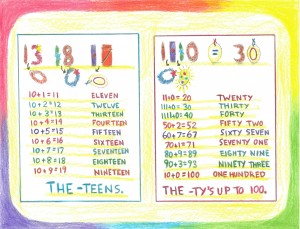
Tags:
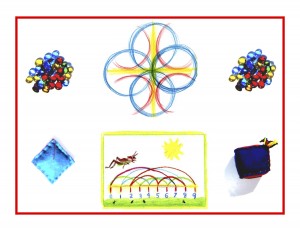
Day 103
For one year, 365 days, this blog will address the Common Core Standards from the perspective of creating an alternate, ambient learning environment for math. Ambient is defined as “existing or present on all sides, an all-encompassing atmosphere.” And ambient music is defined as: “Quiet and relaxing with melodies that repeat many times.”
Why ambient? A math teaching style that’s whole and all encompassing, with themes that repeat many times through the years, is most likely to be effective and successful. Today’s standard will be listed in blue, followed by its ambient counterpart.
Number and Operations in Base Ten 1.NBT
Extend the counting sequence.
1. Count to 120, starting at any number less than 120. In this range read and write numerals and represent a number of objects with a written numeral.
The 2, 5, and 10 times tables are learned experientially and with lots of rhythmic movement in Grade 1. As mentioned in an earlier post, the 2’s are learned by stepping the numbers: softly while whispering the 1’s, and marching while saying the 2’s out loud. Eventually the 1’s are dropped and just the 2’s remain. The 5’s are learned similarly, counting with the same soft and louder pattern: 1-2-3-4-5 6-7-8-9-10 11-12-13-14-15 . . . After the 5’s are well-known, the 10’s can follow this pattern: 5-10 15-20 25-30 . . . up to 120.
This is one way that counting to 120 can practiced, but it can also be counted in 1’s. There needs to be a bridge or transition from the numbers 1-12 as they are slowly and carefully taught (each one is accompanied by a story, a geometric form, and lots of movement) on to the -teens and -ty’s (20, 30, 40, etc) up to 100. In the Math By Hand Grade 1 Binder, lessons are aligned to California State and National Math Standards. Before the inception of the Common Core, the requirement for Grade 1 was counting up to 100. (At this time I am not planning on revising the standards since Common Core is so much in flux. Besides, the old standards are more user-friendly, child-friendly and developmentally appropriate.) Here is an excerpt from the Math By Hand Grade 1 Binder:
Count, read, and write whole numbers to 100. Know 2s, 5s, 10s to 100.
Move beyond the number 12 to teach the -teens, with glass gems as counters. Using a piece of newsprint paper, draw 10 large ovals (about the size of an egg) in a vertical column on the left, spacing them evenly. Then add gems to each one, 1 for 11, 2 for 12, etc. Replace the gems with color dots, and write each number and its word out on the right side. Have the child(ren) copy yours as you model it on paper or the board. Note that the words for eleven and twelve are different. Their origins go back to the early use of Arabic numerals. The word “eleven” comes from an Old English word meaning, “one left over.” And “twelve,” from a word meaning “two left over.” Except for thirteen and fifteen, the rest just add the suffix -teen to the number. Both suffixes -teen and -ty derive from the word “ten.” Try telling a story like this while showing it visually.
Once upon a time, the numbers were happy to be a small family, from 1 – 10. They knew and understood each other very well, though each one was so different. Then one day, they were asked to count 2 more things than 10. They called the first one “eleven” or “one left over,” and the second one, “twelve,” or “two left over.” Then, they were called upon to count so much more, that they needed to put the numbers together with 10. That’s how the -teens came about, with all the numbers having to stand next to 10. The numbers stood SO close together, that they squeezed the “0” out. Then the things that had to be counted grew and grew to be so many that the 10’s had to stand together, asking all the other numbers to stand there with them. These were called the -ty’s (say “tees”). So, twenty is two 10’s, and thirty is three. First, all of the “1’s” were squeezed out by the other numbers, then the other “0’s” were. So, for example, 3 10s became 30, and 3 10s + 3 became 33!
Include all the numbers to 90, then say that one hundred is ten 10’s. No need to show all the numbers visually, just a sampling’s enough. Be sure to use the Real Numbers as props, then go on to illustrate the -teens and -ty’s on separate pages.
So, the child is brought along slowly and carefully, in a very pictorial way. Lots of illustration and color make up the heart of this lesson and activity, and all of the standard is covered, except for Count to 120 starting at any number less than 120. When teaching from the whole to the parts, there is no need to rush into abstraction. If the numbers are known in sequence and counting order, picking the whole apart can come a little later. But the lesson on -teens and -ty’s does build an excellent foundation for being able to do this, because of the fact that within any group of -ty’s numbers follow the known sequence (1-2-3-4-5-6-7-8-9).
Knowledge ensues in an environment dedicated to imaginative, creative knowing, where student and teacher alike surrender to the ensuing of that knowledge as a worthy goal. More on the Common Core Grade 1 Number and Operations in Base Ten Standards along with their ambient counterparts tomorrow!
Tags:
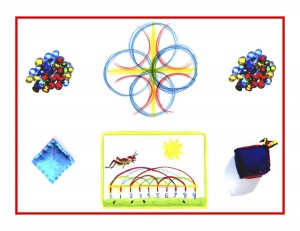
Day 102
For one year, 365 days, this blog will address the Common Core Standards from the perspective of creating an alternate, ambient learning environment for math. Ambient is defined as “existing or present on all sides, an all-encompassing atmosphere.” And ambient music is defined as: “Quiet and relaxing with melodies that repeat many times.”
Why ambient? A math teaching style that’s whole and all encompassing, with themes that repeat many times through the years, is most likely to be effective and successful. As promised, today’s blog will be brief or actually, beyond brief. I’m reprinting Day 98’s post with a few minor adjustments, because it’s such a perfect fit! Today’s standard will be listed in blue, followed by its very ambient counterpart.
Operations and Algebraic Thinking 1.OA
Work with addition and subtraction equations.
8. Determine the unknown whole number in an addition or subtraction equations relating three whole numbers. For example, determine the whole number that makes the equation true in each of the equations 8 + __ = 11, 5 = __ – 3, 6 + 6 = __ .
The unknown number concept works well with the color strips. Using the examples above, place the two strips, green (addition) and blue (subtraction) next to each other.
For addition (green):
Place 8 gems or counters in the first square and 11 in the third.
The white square is second and must show 3 gems.
Place 6 gems or counters in the first square and 6 in the second.
The white square is third and must show 12 gems.
For subtraction (blue):
Place 5 gems in the first square and 3 gems in the third.
The white square is second and must show 8 gems.
Move the white square around to different positions for finding the unknown number (see the Day 98 post for details).
Continue with many similar equations, all under 20, using the gems or counters. Transition to working with the real numbers before writing the equations.
Using the color strips, expand this practice to include multiplication (yellow) and division (red) placed side by side. (Again, see the Day 98 post for details.)
Work with equivalent and inverse equations by comparing addition with multiplication and subtraction with division. Using the colored strips to see all 4 processes together in various relationships is an example of working from the whole to the parts. This is most beneficial, as is using the colored strips and white squares in place of the operation signs at first. This helps to not only simplify the process but also to work with the pictorial or visual aspect, so much more effective than abstract symbols at this age.
Knowledge ensues in an environment dedicated to imaginative, creative knowing, where student and teacher alike surrender to the ensuing of that knowledge as a worthy goal. More on the Common Core Grade 1 Operations and Algebraic Thinking Standards along with their ambient counterparts tomorrow!
Tags:
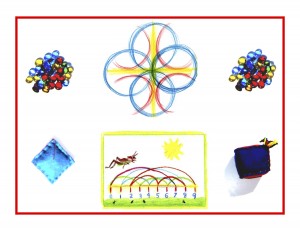
Day 101
For one year, 365 days, this blog will address the Common Core Standards from the perspective of creating an alternate, ambient learning environment for math. Ambient is defined as “existing or present on all sides, an all-encompassing atmosphere.” And ambient music is defined as: “Quiet and relaxing with melodies that repeat many times.”
Why ambient? A math teaching style that’s whole and all encompassing, with themes that repeat many times through the years, is most likely to be effective and successful. Today’s post will continue with the Common Core Standards for Grade 1, listed in blue and followed by their ambient counterparts.
But first, I just need to say at 101 days I am a bit blog-weary. So today’s and tomorrow’s posts will be brief. (It does help that these two standards are quite straightforward and simple.) Next, on to the briar patch of place value. All the more so because both Waldorf and Math By Hand do not teach place value directly until Grade 2. But it may be possible to lay the foundation with age-appropriate lessons and activities, we’ll see. On to #7.
Operations and Algebraic Thinking 1.OA
Add and subtract within 20.
7. Understand the meaning of the equal sign, and determine if equations involving addition and subtraction are true or false. For example, which of the following equations are true and which are false? 6 = 6, 7 = 8 – 1, 5 + 2 = 2 + 5, 4 + 1 = 5 + 2.
This sort of activity is best not done on paper at first. Worksheets are not appropriate either. And you may want to substitute “is” for “equals” at this stage, since it’s more direct. Here are a few ambient, alternative suggestions:
Using a play clay equal sign, glass gems or other manipulatives, and the 4 processes color-coded strips, set up equations like those above and ask if they’re correct. Allowing enough time for counting and exploration to discover the answer, have your child use special markers to say yes or no. For example, shells = yes, small stones = no. After checking the markers, change those that need to be changed, while reviewing them. Then say that all the stones need to be changed to shells, providing guidance where needed. As always, making the abstract concrete is key.
Using a beanbag or a soft ball, play a game of math catch while saying the equations. As the child catches the ball, s/he says yes or no, providing the correct equations where needed. If you say “6 is 6” the child says yes as s/he catches the ball. If you say “5 + 2 is 8” the child says no as s/he catches the ball and says ” 5 + 2 is 7″ as s/he tosses it back to you. Be slow and deliberate with this, and bring it sparingly because of the child’s deep respect for you as the teacher to always tell the truth. Time enough for critical thinking later on!
Knowledge ensues in an environment dedicated to imaginative, creative knowing, where student and teacher alike surrender to the ensuing of that knowledge as a worthy goal. More on the Common Core Grade 1 Operations and Algebraic Thinking Standards along with their ambient counterparts tomorrow!
Tags:
Day 100 (yay, triple digits!)
For one year, 365 days, this blog will address the Common Core Standards from the perspective of creating an alternate, ambient learning environment for math. Ambient is defined as “existing or present on all sides, an all-encompassing atmosphere.” And ambient music is defined as: “Quiet and relaxing with melodies that repeat many times.”
Why ambient? A math teaching style that’s whole and all encompassing, with themes that repeat many times through the years, is most likely to be effective and successful. Today’s post will continue with the Common Core Standards for Grade 1, listed in blue and followed by their ambient counterparts.
Operations and Algebraic Thinking 1.OA
Add and subtract within 20.
6. Add and subtract within 20, demonstrating fluency for addition and subtraction within 10. Use strategies such as counting on; making ten (e.g., 8 + 6 = 8 + 2 + 4 = 10 + 4 = 14); decomposing a number leading to a ten (e.g., 13 – 4 = 13 – 3 – 1 = 10 – 1 = 9); using the relationship between addition and subtraction (e.g., knowing that 8 + 4 = 12, one knows 12 – 8 = 4); and creating equivalent but easier known sums (e.g., adding 6 + 7 by creating the known equivalent 6 + 6 + 1 = 13).
Wow. This is the basis of one of the Common Core controversies that’s all over the internet, posted by confused parents defending children stressed over too much homework and testing. And coming to the aid of teachers who are stressed over possible censure and/or threats of job loss. All that aside, it’s a mistaken “improvement” on existing math methods. This sort of juggling numbers requires a good deal of abstract thinking which is developmentally beyond the ken of first graders. Manipulatives are most likely being used in some cases to teach this, but it still demands more than a 7 year old is able to handle.
Some of the Common Core demonstration lessons I’ve seen use snap-together plastic cubes as manipulatives to solve these equations. And there are many colorful, imaginative plastic sets available as classroom kits, like 20 plastic strawberries in a plastic basket, or whole picnic-themed sets with several different items, used for counting, addition and subtraction. These are specifically aligned to Common Core coordinated worksheets, either consumable pencil and paper or laminated to be used with wipe off crayons/markers. All of this is pre-fab and truly deadens the creative impulse every child is born with.
Using simple, natural materials as manipulatives and creating child/parent-made learning tools is far superior. The Math By Hand glass gems and colored paper strips are a good example of this. Re making ten, decomposing to lead to a ten, or creating equivalent, easier known sums, these may all be seen as mental shortcuts and could be valuable at the right age and place, which Grade 1 is decidedly not. Basic and straightforward beginnings are best, such as learning addition, subtraction, multiplication, and division side by side with simple visual aids. This is a good way to practice the section of the standard that asks for juxtaposing addition and subtraction.
Knowledge ensues in an environment dedicated to imaginative, creative knowing, where student and teacher alike surrender to the ensuing of that knowledge as a worthy goal. More on the Common Core Grade 1 Operations and Algebraic Thinking Standards along with their ambient counterparts tomorrow!
Tags:
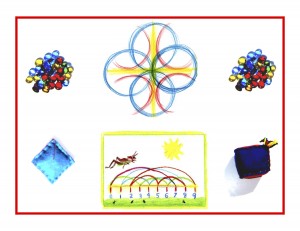
Day 99
For one year, 365 days, this blog will address the Common Core Standards from the perspective of creating an alternate, ambient learning environment for math. Ambient is defined as “existing or present on all sides, an all-encompassing atmosphere.” And ambient music is defined as: “Quiet and relaxing with melodies that repeat many times.”
Why ambient? A math teaching style that’s whole and all encompassing, with themes that repeat many times through the years, is most likely to be effective and successful. Today’s post will continue with the Common Core Standards for Grade 1, listed in blue and followed by their ambient counterparts.
Operations and Algebraic Thinking 1.OA
Add and subtract within 20.
5. Relate counting to addition and subtraction (e.g., by counting on 2 to add 2).
In the Waldorf Grade 1, rhythmic counting is used for more than one purpose: to learn to count up to 100 by 1’s and to learn some of the times tables. Counting by 2 happens this way: the children whisper and step lightly on the 1, 3, 5, 7, etc. while stamping and speaking the 2, 4, 6, etc. The odd numbers are later dropped and just the 2’s are spoken and rhythmically stepped. The 2’s can be further enhanced by clapping, skipping, waving a small flag, or playing a tambourine. Rhythm and meter are close friends of math, and they provide the best means to effectively teach and learn it.
Counting to add and subtract is made clearer and more accessible by using manipulatives like the glass gems. This can be done with equations or composing and decomposing numbers, and can also later translate to factoring composite numbers. The 4 processes should always be viewed as comparable and parallel. Just as counting on 2 can be used for multiplication as well as addition, it can also be used for division along with subtraction. The glass gems, then the real numbers, and finally pencil and paper can be used for this.
Knowledge ensues in an environment dedicated to imaginative, creative knowing, where student and teacher alike surrender to the ensuing of that knowledge as a worthy goal. More on the Common Core Grade 1 Operations and Algebraic Thinking Standards along with their ambient counterparts tomorrow!
Tags:
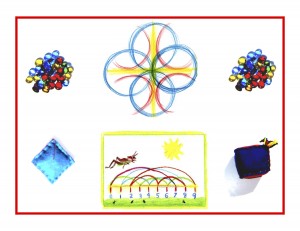
Day 98
For one year, 365 days, this blog will address the Common Core Standards from the perspective of creating an alternate, ambient learning environment for math. Ambient is defined as “existing or present on all sides, an all-encompassing atmosphere.” And ambient music is defined as: “Quiet and relaxing with melodies that repeat many times.”
Why ambient? A math teaching style that’s whole and all encompassing, with themes that repeat many times through the years, is most likely to be effective and successful. Today’s post will continue with the Common Core Standards for Grade 1, listed in blue and followed by their ambient counterparts.
Operations and Algebraic Thinking 1.OA
Understand and apply properties of operations and the relationship between addition and subtraction.
4. Understand subtraction as an unknown addend problem. For example, subtract 10 – 8 by finding the number that makes 10 when added to 8.
The unknown number concept works well with the color strips. Using this example, place the two strips, green (addition) and blue (subtraction) next to each other.
For addition (green):
Place 8 gems or counters in the first square and 2 in the second.
The white square is third for the answer: 10 gems.
For subtraction (blue):
Place 10 gems in the first square and 8 gems in the second.
The white square is third for the answer: 2 gems.
Move the white square around to different positions for finding the unknown number:
___ + 2 = 10, 8 + ___ = 10. Or ___ – 8 = 2, 10 – ___ = 2.
Continue with many similar equations, all under 20, using the gems or counters. Transition to working with the real numbers before writing the equations.
Using the color strips, expand this practice to include multiplication (yellow) and division (red) placed side by side. (Note that in Grade 1, the 2, 5, and 10 tables are learned.)
For 6 x 2 = 12 multiplication (yellow):
Place 6 gems in the first square and 2 gems in the second.
The white square is third with the answer: 12 gems.
For division (red):
Place 12 gems in the first square and 6 gems in the second.
The white square is third with the answer: 2 gems.
Move the white square around to different positions for finding the unknown number:
___ x 2 = 12, 6 x ___ = 12. Or ___ / 6 = 2, 12 / ___ = 2.
Continue with many similar equations, all under 20, using the gems or counters. Transition to working with the real numbers before writing the equations.
Work with equivalent and inverse equations by comparing addition with multiplication and subtraction with division. Using the colored strips to see all 4 processes together in various relationships is working from the whole to the parts. This is most beneficial, as is having the colored strips and white squares take the place of the operation signs at first helps not only to simplify the process but also relies on the visual aspect, which is so much more effective than abstract symbols at this age.
Knowledge ensues in an environment dedicated to imaginative, creative knowing, where student and teacher alike surrender to the ensuing of that knowledge as a worthy goal. More on the Common Core Grade 1 Operations and Algebraic Thinking Standards along with their ambient counterparts tomorrow!
Tags:
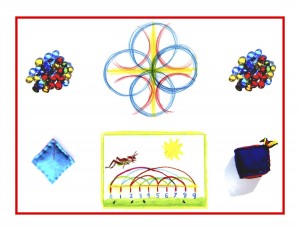
Day 97
For one year, 365 days, this blog will address the Common Core Standards from the perspective of creating an alternate, ambient learning environment for math. Ambient is defined as “existing or present on all sides, an all-encompassing atmosphere.” And ambient music is defined as: “Quiet and relaxing with melodies that repeat many times.”
Why ambient? A math teaching style that’s whole and all encompassing, with themes that repeat many times through the years, is most likely to be effective and successful. Today’s post will continue with the Common Core Standards for Grade 1, listed in blue and followed by their ambient counterparts.
Operations and Algebraic Thinking 1.OA
Understand and apply properties of operations and the relationship between addition and subtraction.
3. Apply properties of operations as strategies to add and subtract. Examples: if 8 + 3 = 11 is known, then 3 + 8 = 11 is also known. (Commutative property of addition.) To add 2 + 6 + 4, the second two numbers can be added to make a 10, so 2 + 6 + 4 = 2 + 10 = 12. (Associative property of addition.)
Math By Hand introduces all three properties: associative, commutative, and distributive, in the Grade 2 Daily Lesson Plans book, in a thoroughly concrete and playful way. When concepts are presented too abstractly too soon, it results in confusion, anger, and loss of confidence. This is what we see happening with the protest by parents trying to understand and help their children with Common Core homework. And with parents deciding to opt their children out of testing because it will likely fail them, even those who were high math achievers until the Common Core came along.
The “high stakes” nature of the testing has put teachers and children at risk: failure, mislabeling as learning challenged, and losing a grade for children, censure and job loss for teachers. High stakes then becomes high stress, for teachers, children, and parents alike. It would be immeasurably better for Grades 1-3 (Kindergarten is intentionally omitted) to learn the basics first, before tackling the more abstract properties. There certainly can be some flexibility within this though, as mentioned yesterday. When using the color strips, the blank, white square can be placed anywhere to represent either the answer or a missing number. This allows a flexibility of thinking that can later translate to algebraic concepts.
As previously stated, working with all 4 processes at once allows a broader, more effective comparison. Knowledge ensues in an environment dedicated to imaginative, creative knowing, where student and teacher alike surrender to the ensuing of that knowledge as a worthy goal. Tune in tomorrow for more on the Common Core Grade 1 Operations and Algebraic Thinking Standards along with their ambient counterparts.
Tags:

